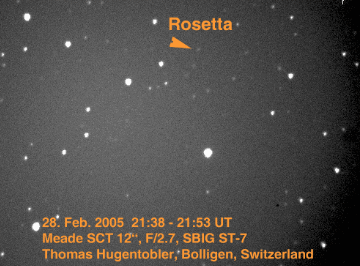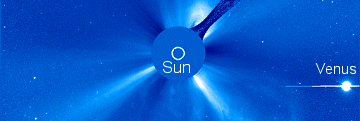QUIET SUN: With only one tiny sunspot facing Earth, the sun looks impressively blank today. Solar activity should remain low.
 Would you like a call when the ISS is about to fly over your backyard? Sign up for SpaceWeather PHONE.
Would you like a call when the ISS is about to fly over your backyard? Sign up for SpaceWeather PHONE.
ROSETTA FLYBY: The European Space Agency's Rosetta probe, en route to land on a comet, is about to fly past Earth. Closest approach: 1900 km. Amateur astronomers in Europe can see it at sunset on March 4th. The spacecraft will glow about as brightly as an 8th- or 9th-magnitude star--too dim for the unaided eye but an easy target for backyard telescopes. [full story] [finder charts] [photo contest]

Above: As seen through a 12-inch telescope, the Rosetta spacecraft approaches Earth on Feb. 28th. Photo credit: Thomas Hugentobler of Bolligen, Switzerland.
ROSETTA UPDATE: Astronomer Frank Reddy has prepared an eye-popping simulation of the Rosetta flyby. See it: 17 MB (mpeg format) or 8 MB (RealPlayer format).
WHERE'S VENUS? Have you noticed something missing from the dawn sky? The brightest planet of all, Venus, has disappeared.
Actually, it's just hiding. This month Venus is orbiting behind the Sun where we can't see it because of the glare. The Solar and Heliospheric Observatory (SOHO), however, can see Venus using its coronagraph to block the Sun. Witness this SOHO image from March 1st:

Venus is so bright, it overloads the coronagraph's digital camera, bleeding into adjacent pixels. That's why there's a horizontal line running through Venus. The planet doesn't really have rings, it's a digital artifact.
Throughout March, you can watch Venus glide by the Sun on SOHO's realtime images website. In April, Venus will emerge again, becoming a bright and beautiful evening "star" that you can see with your own two eyes. Stay tuned!
RAINBOWS ON TITAN: Like Earth, Titan is a wet place, but Titan's "water" is not like ours. Read this story from Science@NASA to find out about boats, waves, rain and rainbows on Saturn's giant moon.

